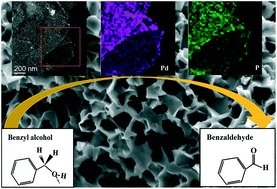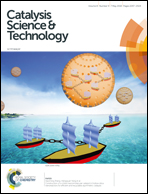Pd–P nanoalloys supported on a porous carbon frame as an efficient catalyst for benzyl alcohol oxidation†
Abstract
In this work, a novel porous carbon frame (PCF) is obtained by an economical and effective method and acts as a support in the process of forming the catalyst. A phosphorus-doped palladium alloy supported on the PCF (Pd–P/PCF) is synthesized using sodium hypophosphite (NaH2PO2) as the P source and the reducing agent, and is used as an efficient catalyst for benzyl alcohol oxidation. Pd–P/PCF shows better catalytic performance than the analogous catalyst synthesized using NaBH4 as the reducing agent (Pd/PCF). Surface analysis of the catalyst before and after the oxidation reaction shows that the embedded P atoms may affect the 3d electron density of Pd and may further weaken the binding of alcohol intermediates, thus promoting the catalytic performance of Pd–P/PCF. In addition, due to the introduction of P, the functional groups of the catalyst are different in comparison with Pd/PCF. The stronger alkalinity and hydrophobicity of these groups can effectively facilitate the adsorption of benzyl alcohol and the subsequent desorption of the corresponding aldehyde, thereby promoting the overall rate of reaction.



 Please wait while we load your content...
Please wait while we load your content...